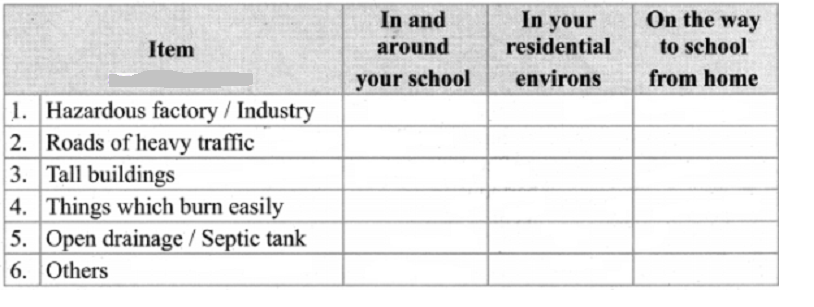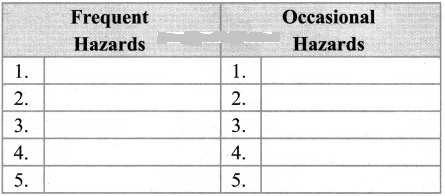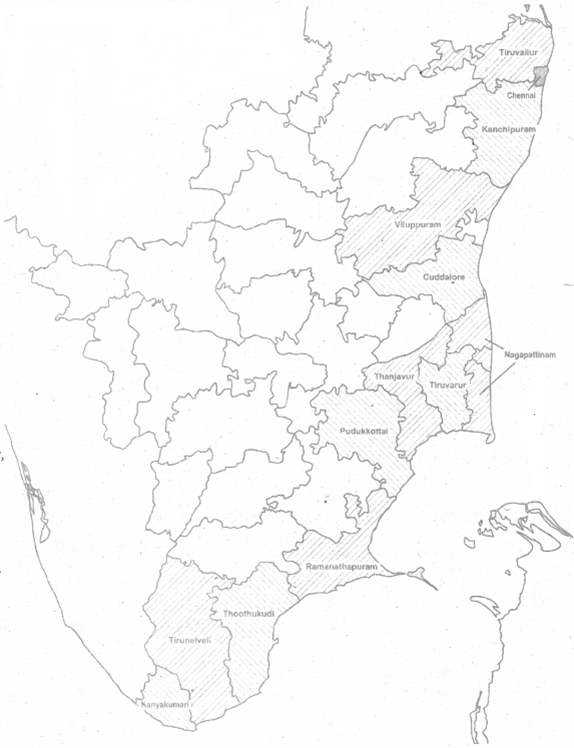8th Social Science – Geography Book Back
& Questions Answers (solution)
Term 2
2. Hazards
8th Social Science Geography Solutions Term 2 – Chapter 2 Hazards Tamilnadu Samacheer Kalvi – English Medium
I. Choose the correct answer
- ……………. percentage of nitrogen is present in the air.
(a) 78.09%
(b) 74.08%
(c) 80.07%
(d) 76.63%
Answer: (a) 78.09%
2. Tsunami in Indian Ocean took place in the s ear …………….
(a) 1990
(b) 2004
(c) 2005
(d) 2008
Answer: (b) 2004
3. The word tsunami is derived from ……………. language.
(a) Hindi
(b) French
(c) Japanese
(d) German
Answer: (c) Japanese
4. The example of surface water is –
(a) Artesian well
(b) Groundwater
(c) Subsurface water
(d) Lake
Answer: (d) Lake
5. Event that occurs due to the failure of monsoons.
(a) Condensation
(b) Drought
(c) Evaporation
(d) Precipitation
Answer: (b) Drought
II. Fill in the blanks
- Hazards may lead to ……………..
- Landslide is an example of …………….. hazard.
- On the basis of origin, hazard can be grouped into …………….. categories.
- Terrorism is an example of …………….. hazard.
- Oxides of Nitrogen are …………….. pollutants which affects the human beings.
- Chernobyl nuclear accident took place in ……………..
Answer:
- disaster
- Geologic (or) Seismic
- Eight
- Human – induced
- Primary
- 26th April 1986
III. Match the following
Answer:

IV Answer in brief
1. Define ‘hazard’.
Answer:
‘Hazards are defined as a thing, person, event or factor that poses a threat to people, structures or economic assets and which may cause a disaster.’
2. What are the major types of hazards?
Answer:
- Atmospheric hazard
- Geologic 7 Seismic hazard
- Hydrologic hazard
- Volcanic hazard
- Environmental hazard
- Biological hazard
- Human – induced hazard
- Technological hazard
3. Write a brief note on hazardous wastes.
Answer:
The wastes that may or tend to cause adverse health effects on the ecosystem and human beings are called hazardous wastes.
4. List out the major flood prone areas of our country.
Answer:
- The major flood prone areas in north and northeast India are, Punjab, Haryana, Uttar Pradesh, North Bihar, West Bengal and Brahmaputra valley.
- Coastal Andhra Pradesh, Odisha and Southern Gujarat are the other regions which are also prone to flood often.
5. Mention the types of drought.
Answer:
Drought could be classified into three types. They are:
- Meteorological drought
- Hydrological drought
- Agricultural drought
6. Why should not we construct houses at foothill areas?
Answer:
We should not construct houses at foothill areas because it has rapid downward movement of rocks and soil and vegetation down the slope under the influence of gravity which leads to landslides.
V. Distinguish the following :
1. Hazards and disasters.
Answer:
1. Hazard:
A natural hazard is a natural process and event that is a potential threat to human life and property.
2. Disasters:
A disaster is a hazardous event that occurs over a limited time span in a defined area and causes great damage to property / loss of life, also needs assistance from others.
2. Natural hazard and human-made hazard.
Answer:
Natural Hazards:
- These are the results of natural processes and man has no role to play in such hazards.
- For example: Earthquakes, Floods, Cyclonic storms and volcanic eruption etc.
Human – made – Hazards:
- These are caused by undesirable activities of human. It can be the result of an accident such as an industrial chemical leak or oil spill.
- For example: Hazardous wastes, pollution of air, water and land etc.
3. Flood and drought.
Answer:
Flood:
- Flood is an event in which a part of the earth’s surface gets inundated.
- Heavy rainfall and large waves in seas are the common causes of flood.
Drought:
- Any lack of water to satisfy the normal needs of agriculture, livestock, industry or human population may be termed as a drought.
- Droughts in India occur in the event of a failure of monsoon.
4. Earthquake and tsunami.
Answer:
1. Earthquake:
Earthquake is a violent tremor in the earth’s crust, sending out a series of stock waves in all directions from its place of origin.
2. Tsunami:
Tsunami refers to huge ocean waves caused by an earthquake, landslide or volcanic eruption. It is generally noticed in the coastal regions and travel between 640 and 960 Km/h.
VI. Answer in a paragraph
1. Write an essay on air pollution.
Answer:
Pollution of Air :
1. Air is a mixture of several gases.
2. The main gases are nitrogen (78.09%) for forming products such as fertilizers for plants and for making the air inert, oxygen (20.95%) for breathing and carbon dioxide (0.03%) for photosynthesis.
3. Some other gases like argon, neon, helium, krypton, hydrogen, zenon and methane are also present.
4. Air pollution is the contamination of the indoor or outdoor air by a range of gases. Air pollution can be categorized into primary and secondary pollutants.
5. A primary pollutant is an air pollutant emitted directly from a source.
6. A secondary pollutant is not directly emitted.
7. Primary pollutants are as follows:
- Oxides of Sulphur
- Oxides of Nitrogen
- Oxides of Carbon
- Particulate Matter and
- Other primary pollutants
8. Secondary pollutants are as follows:
- Ground Level Ozone
- Smog
2. Define earthquake and list out its effects.
Answer:
Earthquakes:
Earthquake is a violent tremor in the earth’s crust, sending out a series of shock waves in all directions from its place of origin.
Effects of Earthquakes:
- The Primary effects of earthquakes are ground shaking, ground rupture, landslides, Tsunamis and soil liquefaction.
- The Secondary effects of earthquakes are fires.
- The effects of earthquakes are terrible and devasting. Thus leads to distraction of buildings, loss of money, property and lines of people. This affects the mental and emotional health of people.
3. Give a detailed explanation on the causes of landslides.
Answer:
1. Landslide is a rapid downward movement of rock, soil and vegetation down the slope under the influence of gravity.
2. The causes of landslides are wide ranging, They have two aspects in common.
3. Force of gravity and
4. Failure of Soil
5. Landslides are considered of two types. They are:
- Naturally occuring disaster.
- Human induced changes in the environment.
6. Natural causes of landslides are:
- Climatic changes
- Seismic activities
- Weathering
- Soil erosion
- Forest fires
- Gravity and
- Volcanic eruption
7. Human causes of landslides includes deforestation mining, construction of roads and railways over the mountain.
4. Elaborately discuss the effects water pollution.
Answer:
Water Pollution:
- Water pollution may be defined as alteration in the physical, chemical and biological characteristics of water which may cause harmful effects in human and aquatic life.
- In India, water pollution has been taking place on a large scale.
- Some of these waterborne diseases are Typhoid, Cholera, Paratyphoid fever, Dysentery, Jaundice and Malaria.
- Chemicals in the water also have negative effects on our health.
- Pesticides – can damage the nervous system and cause cancer because of the Carbonates and organophosphere that they may contain.
- Both surface and groundwater bodies are polluted to a great extent.
VII. Activities
1. Name the hazards which you have identified.

Answer:
Activity to be done by the students.
2. List out the hazards that occur frequently and occasionally in your place.

Answer:
Activity to be done by the students.
3. On the map of Tamilnadu shade the 13 coastal districts in different colors.
Answer:

Tags:
8th social guide samacheer kalvi,samacheer kalvi 8th books guide social science,social guide for 8th standard samacheer kalvi,samacheer kalvi guru 8th social guide,8th standard social guide samacheer kalvi,samacheer kalvi 8th social guide pdf,8th social guide tamil medium samacheer kalvi,8th social guide tamil medium samacheer kalvi,samacheer kalvi 8th books guide social science,samacheer kalvi guru 8th social guide,samacheer kalvi 8th social guide pdf,8th standard social guide samacheer kalvi,8th social guide tamil medium samacheer kalvi,8th social guide tamil medium samacheer kalvi,social guide for 8th standard samacheer kalvi,samacheer kalvi 8th books guide social science,samacheer kalvi guru 8th social guide,social guide for 8th standard samacheer kalvi,samacheer kalvi 8th social guide pdf,8th standard social guide samacheer kalvi,samacheer kalvi 8th books guide social science,samacheer kalvi guru 8th social guide,social guide for 8th standard samacheer kalvi,8th social guide tamil medium samacheer kalvi,8th standard social guide samacheer kalvi,8th social guide tamil medium samacheer kalvi,samacheer kalvi 8th social guide pdf,samacheer kalvi 8th books guide social science,social guide for 8th standard samacheer kalvi,samacheer kalvi guru 8th social guide,8th social guide tamil medium samacheer kalvi,8th standard social guide samacheer kalvi,samacheer kalvi 8th social guide pdf,8th social guide tamil medium samacheer kalvi,samacheer kalvi 8th books guide social science,social guide for 8th standard samacheer kalvi,samacheer kalvi guru 8th social guide,8th social guide tamil medium samacheer kalvi,8th social guide tamil medium samacheer kalvi,samacheer kalvi 8th social guide pdf,8th standard social guide samacheer kalvi,samacheer kalvi 8th books guide social science,samacheer kalvi guru 8th social guide,social guide for 8th standard samacheer kalvi,samacheer kalvi 8th social guide pdf,8th standard social guide samacheer kalvi,8th social guide tamil medium samacheer kalvi,samacheer kalvi 8th books guide social science,social guide for 8th standard samacheer kalvi,samacheer kalvi guru 8th social guide,8th social guide tamil medium samacheer kalvi,8th standard social guide samacheer kalvi,samacheer kalvi 8th social guide pdf,8th social guide tamil medium samacheer kalvi,


